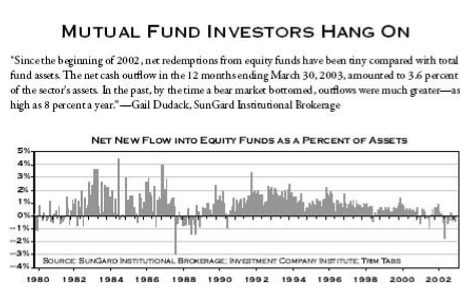There are two massive financial traits this decade:
1. Customers hold spending cash it doesn’t matter what.
2. Traders hold shopping for the dip it doesn’t matter what.
Individuals hold ready for these traits to interrupt however they merely received’t. Not but at the least.
What’s it going to take?
One would think about a recession would break the spending patterns for a lot of customers. We will see. Inflation didn’t do it.
I’m undecided what it’s going to take to cease traders from entering into purchase the ache when shares are down.
April has been an especially unstable setting for the inventory market. Traders aren’t dashing for the exits, at the least of the retail selection.
Retail has been a purchaser:

I wrote a bit again in 2014 known as Millennials & The New Demise of Equities. This was from a UBS report on the time:
The Subsequent Gen investor is markedly conservative, extra just like the WWII technology who got here of age through the Nice Despair and are in retirement. This interprets into their angle towards the market as we see Millennials, together with these with larger internet value, holding considerably more money than another technology. And whereas optimistic about their skills to attain objectives and their monetary futures, Millennials appear considerably skeptical about long-term investing as the way in which to get there.
The bursting of the dot-com bubble mixed with the Nice Monetary Disaster unnerved a whole lot of traders. Millennials have been skeptical of markets.
The subsequent technology now has a very totally different relationship with danger.
The Wall Road Journal profiled a handful of youthful traders to see how the volatility is impacting their funding choices. They’re leaning into the ache:
“It’s only a screaming shopping for alternative,” mentioned Oksnevad, who retains about 90% of his seven-figure portfolio–together with retirement funds–within the cryptocurrency and associated shares reminiscent of bitcoin purchaser Technique. “I’m working straight into it.”
The 37-year-old advertising and marketing director didn’t thoughts that the value of bitcoin sank almost 6% that day, or that he was growing his publicity to a comparatively dangerous asset throughout probably the most vital market meltdown since March 2020. As a substitute, he centered on the prospect of a rebound.
“That’s what I’m after–making many years of returns in weeks or months,” he mentioned. “I actually suppose volatility is the place fortunes are made.”
Right here’s one other one:
“The children lately say, ‘No danger, no ‘rari,’” mentioned Patrick Wieland, a content material creator and day dealer who has in current weeks poured 1000’s of {dollars} into ProShares UltraPro QQQ. (“Rari” is slang for Ferrari.) Shares of the fund, a triple-leveraged ETF that goals to generate 3 times the every day efficiency of the Nasdaq-100 index, notched double-digit positive factors throughout a historic rally on April 9, however are nonetheless down greater than 20% this month.
“I believe you’ve acquired to be aggressive,” he mentioned. “When you might have such massive swings out there, it’s laborious to be danger averse.”
The bull market and pandemic-induced positive factors have created a brand new breed of traders who aren’t afraid of volatility. They’re dashing into the burning constructing.
Some traders may quibble with their automobiles of selection however this habits is noteworthy. For years and years it’s been drilled into the heads of traders that falling markets are a chance. I believe it’s nice that youthful traders have discovered this lesson so early.
May they ultimately be taught one other lesson when the subsequent misplaced decade comes round? Certain, however these intervals aren’t straightforward for any investor, no matter age and expertise.
It’s additionally no assure {that a} gigantic market crash would instantly change investor habits.
The bull market of the Nineteen Eighties and Nineties have been one other wonderful interval when traders discovered the artwork of long-term investing and shopping for the dip. Even when the inventory market fell 50% through the bursting of the dot-com bubble, most traders stayed the course.
Maggie Mahar chronicled this era in her e book Bull:
So, even after it turned clear to the overwhelming majority of traders that the Nice Bull Market of 1982-99 had ended, mutual fund traders stood agency. The mass redemptions from fairness funds that many had predicted by no means happened. As late as March 2003, Gail Dudack noticed: “Internet redemptions because the starting of 2002 have been tiny in contrast with whole inventory fund property. The web money outflow within the 12 months ending March 30, 2003, amounted to three.6 p.c of the sector’s property.
Right here’s the visible:

In 2002, the inventory market was down 22% however Vanguard discovered the typical account stability grew by 1% as a result of folks stored funneling cash into the market.
It wasn’t till the 2008 disaster that many traders started tapping out.
As soon as a behavior types it’s not that straightforward to interrupt the sample.
Possibly a recession will do it, however the subsequent technology of traders is snug with volatility.
That’s a welcome growth.
Michael and I talked about traders shopping for the dip and way more on this week’s Animal Spirits video:
Subscribe to The Compound so that you by no means miss an episode.
Additional Studying:
One of many Greatest Funding Books I’ve Learn in a Whereas
Now right here’s what I’ve been studying these days:
Books:

